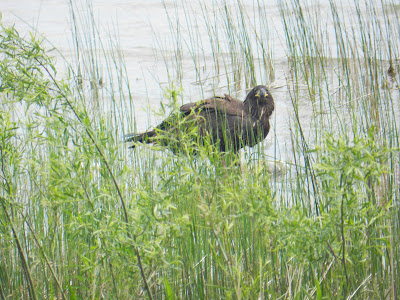 |
| Essar steel mill in Canadian Soo. |
Tom Wilson, Island dentist, and I went on our second annual U.P. road trip this past weekend, which took us to Sault Ste. Marie, among other places. Friday evening's rain, much needed in the eastern Upper Peninsula where there have been many wooded acres burned in the past month, gave way to sunshine as we cruised on the upper St. Mary's river in Le Voyageur, a craft operated by Soo Locks Tours that closely resembled our old C. G. Richter. Not surprising, the Naval Architect was the same Walter Haertel, and the builder for each vessel was Sturgeon Bay Shipbuilding and Dry Dock.
 |
| Laker Cason J. Calloway approaches lock loaded with ore. Great Lakes Maritime Academy training vessel follows. |
Our weekend tour continued with a drive to the maritime museum at Whitefish Point, then Tequamenon Falls, with time to scoot to Boyne City on the mitten (yes, Michigan has a real mitten shape down-state) and dinner with our youngest son, Thor, at a fantastic Italian restaurant. This is in the same neighborhood as Hemingway's old haunt of Horton's Bay.
After a night in St. Ignace, we hit the road again for home Sunday morning and stopped briefly in the early afternoon at the Peshtigo Fire Museum. Over 1200 lives were lost in an evening firestorm, we learned. I've always wanted to stop at this museum (and did once on my motorcycle, but it had closed) and compare notes with southern Door County's Williamsonville fire of the same date in October 1871.
Williamsonville was a settlement within the Town of Brussels, actually a shingle mill owned by the Williamson brothers. A much more broad area than the Town of Brussels and parts of southern Door County that were burned on the east side of the Bay, but even more lives and acres were burned in the country surrounding Peshtigo.
We covered a lot of ground in three days, surpassing, by my estimate, the 1200 driving miles we put on during last year's excursion. Among the memorable sights was Canada's Essar mill. Somehow, the billowing smoke and piles of raw materials gave me a warm and friendly feeling: the essence of production with the piles of taconite, coal and limestone, and even more impressive were the enormous piles of slag. A truck dumped a load of orange, molten slag as we cruised, and exposure to oxygen brought on an eruption of smoke, causing a youngster to point and exclaim to his parents, "Look, a volcano!" He was right, it had that appearance.
And while that industrial setting may no longer be observed in the U.S. - due to environmental laws and the times, as well as imported steel - there was an endearing quality about this example of heavy industry (with its 4000+ jobs, according to our narrator), and the tangible, finished coils of rolled steel at the end of the pier, waiting to be shipped to customers.
There's a lot to be seen and learned by visiting our Great Lakes waterway neighbors.
May's weather -
Island weather observer John Delwiche dropped off his monthly synopsis for May the other day, and here are a few of the highlights:
A record high was recorded of 78 on 05/16, which also happened to be the first 70 degree day in 2012. I'm not sure if we hit 70 again since then - just kidding - but it has been on the cool side of late. Our May precipitation total was 1.80". That figure is less than half the average precipitation of 2.87". We remain nearly two inches off the precipitation average for the year.
Lake levels, as had been predicted by the Army Corps, fell off slightly rather than continuing to rise, as would be expected up to July, given normal snowmelt and spring rains.
Wisconsin said "No" to Town's application -
We heard via Town Chairman Joel Gunnlaugsson late last Thursday that the Town of Washington's Harbor Assistance Program grant application was NOT selected for approval. There were other applicants, and we understand that Washington Island did not receive a funding recommendation. In fact, we were at the bottom of the list. Where does that leave us, given continued low water and the prospect for perhaps even lower future lake levels?
We're bound to learn more details during the next week. A renewed application effort is one possibility.
Eagles eat, too -
Eagles are seen more frequently along these shores, from Rock Island to Washington, Plum and along the peninsula, to the point where sightings are no longer considered unusual. However, they're still fun to watch and exciting to see, flying or sitting, and part of this has to do with their size and their habits.
We watched six immature eagles, in varying degrees of white and brownish-black feathers, roosting in one tree last Sunday afternoon. Below them, at water's edge, were three egrets. And just beyond the egrets was a pair of white (black-tipped wings) pelicans. Nearby, geese swam with their young.
The resident great blue heron had taken the afternoon off, and he was absent from the scene, but neighbor Connie sees him - or her - often, sometimes with a snake wrapped in its bill.
A rather incredible Detroit Harbor sight, all of these birds seen together.
This noon, while eating lunch at our kitchen table, I looked out the window and watched an eagle doing the same, only with a dead fish, among the grasses near shore. A seagull and a second eagle waited above to claim the leftovers.
It's never too late to get a good pair of binoculars and enjoy spotting these impressive birds.
- Dick Purinton



1 comment:
They are a very welcome addition to the Island.
Post a Comment